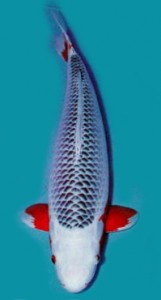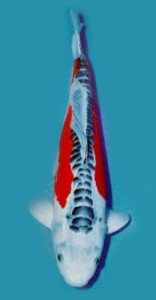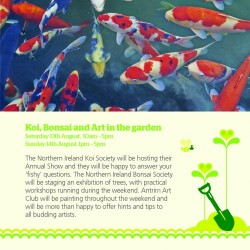Asagi / Shusui
 One of the earliest varieties in the history of Nishikigoi going back some 160 years. The Asagi was developed from Asagi Magoi, one of the three varieties of black carp. The deep blue scales with pale edgings combined with red sides, cheeks and fin joints produce a distinctive and easily recognised Koi with a restrained beauty.
One of the earliest varieties in the history of Nishikigoi going back some 160 years. The Asagi was developed from Asagi Magoi, one of the three varieties of black carp. The deep blue scales with pale edgings combined with red sides, cheeks and fin joints produce a distinctive and easily recognised Koi with a restrained beauty.
There are said to be three types of Asagi named according to their shade of blue.
• The Konjo Asagi, the darkest blue variety and least valued.
• The Narumi Asagi, named after the Narumi district of Japan renowned for its tie-dyed fabrics. A lighter blue, with its deep blue centre and pale outer edging to each scale is the most typical Asagi.
• The third variety is the Mizu Asagi which is the palest, almost grey. In practice all three are generally just known as Asagi. As it is difficult to know where one variety ends and another begins this is perhaps the safest course.
The main features to look for are a clear pale blue head without underlying shading or staining. Evenness of scaling is also vital with each scale being clearly defined with its darker blue centre-colour contrasted by paler outer edge to produce a clear reticulated pattern from head to tail. The Hi marking should be a vivid red running along the sides of the Koi but not above the lateral line. There should be no Hi on the back. The Hi continues through the gill plates and onto the cheeks and jaw preferably in a symmetrical pattern. The base of the fins, especially the pectorals, should also be marked with Hi. Hi on this variety is often orange in colour which is less desirable as it is the vivid red contrasting with the more subdued blue scaling which provides one of the main attractions of this Koi. The underside of the abdomen should be white.
Common faults in this variety are head staining, poor brownish Hi colour, black speckling to the body and misplaced or damaged scaling, all of which seriously downgrade the Koi. However, perhaps the biggest problem is the tendency for the body colour to darken particularly as the Koi grows.
Whilst it is possible to acquire young well-scaled specimens of good blue colour, as they grow the blue generally darkens to grey and individual scale definition is lost. This makes good large specimens retaining colour and definition a rarity in this country. In Japan they do however seem to be able to maintain the blue colour and clear reticulation to maturity. I have yet to hear a satisfactory explanation for this phenomenon although differences in water chemistry and cooler temperature are usually put forward.
Shusui…..

Originally produced by an Asagi Sanke and mirror carp cross, the Shusui is a Doitsu Asagi. The main characteristic of this variety is the line of deep blue scales along the dorsal ridge contrasting with a scaleless pale blue body and Hi markings as found in Asagi. As with all Doitsu Koi, neat well placed scaling is essential. A single row of large deep blue scales starting at the back of the head dividing into a row either side of the dorsal fin before continuing to the base of the tail is the ideal. Misplaced or rogue scales are often found in this variety which do detract and downgrade a Koi. The head, just as with Asagi should be pale and clear without speckling or staining. The pale sky blue of the body of Shusui ought to be clear and of even colour to off-set the deep blue scaling which makes this variety unmistakable.
The Hi markings should be bright and vivid running along the body sides, generally below the lateral line into the sides of the head and cheeks in the same manner as found on Asagi. The base of the pectoral fins should also show this bright red. Shusui with Hi markings between lateral line and dorsal are called Hana Shusui, meaning flowery. Those whose Hi extends all over the back are not surprisingly called Hi Shusui. When this variety is small it is generally very pretty and striking and often appeals to newcomers.
However, a word of caution, if darkening with age is a problem with Asagi, then it is doubly so with Shusui. Very attractive small specimens can change dramatically to become an all-over grey blue colour which, as well as losing their beauty, also lose all value. This makes large specimens which have held their youthful colour a rarity. Perhaps the best advice when considering this variety is to choose those of the Hana or Hi type, those having larger areas of red which are less subject to change. Making any change in the blue body colour much less noticeable. However, if it is the blue colour which really attracts, then you pays your money and takes your choice!
